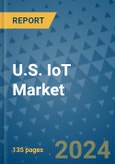The U.S. Internet of Things (IoT) market is on a trajectory of unprecedented growth, according to the latest research from the publisher. With the market valued at US$ 70 billion in 2024 and projected to reach US$ 230 billion by 2031, businesses across various sectors are embracing IoT technology to enhance efficiency, reduce costs, and revolutionize customer experiences.
This product will be delivered within 1-3 business days.
Rapid Expansion Driven by Automation and Enhanced Efficiency
The increasing focus of businesses on automation and improved process efficiency is a key driver fueling the demand for IoT systems and services in the U.S. As companies strive to optimize operations and reduce reliance on human labor, IoT technology emerges as a solution offering enhanced efficiency, automation, and data-driven decision-making capabilities. The COVID-19 pandemic has further accelerated the adoption of IoT technologies, propelling demand for IoT devices and services.Security Concerns Present Challenges
Despite the promising growth, the IoT market faces challenges, primarily concerning security risks associated with IoT solutions. While IoT offers numerous benefits, including increased efficiency and convenience, security breaches pose significant threats, ranging from data theft to physical harm. To mitigate these risks, the IoT industry must prioritize security by implementing comprehensive security mechanisms and standards across all devices and networks.IoT Sensors Lead the Charge
IoT sensors are at the forefront of the U.S. market, occupying a significant share due to the rising adoption of cloud computing technology and the need for efficient data processing systems. With IoT sensors playing a crucial role in gathering, storing, and processing data produced by connected devices, the demand for high-performance sensors is on the rise, fueled by the widespread adoption of connected devices across industries such as healthcare, retail, manufacturing, and transportation.Opportunities for Small- & Mid-sized Organizations
Small- and mid-sized organizations are increasingly turning to IoT solutions, driven by the wide availability of cost-effective options. With limited budgets and resources compared to larger corporations, these businesses seek affordable IoT solutions that offer a positive return on investment. By adopting IoT technology, they can optimize operations, automate processes, and increase efficiency, translating into tangible benefits such as greater productivity and lower operational expenses.Competitive Analysis: Emphasis on Partnerships and Acquisitions
To stay ahead in the competitive IoT market, companies are prioritizing acquisitions and partnerships to enhance their product portfolios and deliver more customized and advanced IoT services. Recent examples include Microsoft's acquisition of CyberX to bolster the security of its Azure IoT platform and Intel's acquisition of SigOpt to enhance its AI and machine learning capabilities for IoT applications. These strategic moves underscore the importance of innovation and collaboration in driving growth and staying competitive in the evolving IoT landscape.Key Companies Profiled
- IBM
- Amazon Web Services, Inc.
- Microsoft Azure
- Google Cloud
- Cisco
- Intel
- Qualcomm
- Siemens
- Verizon
- Dell
Key Segments of U.S. IoT Industry
By Solution:
- Hardware
- IoT Sensors
- IoT Gateways
- IoT Controllers
- Others
- IoT Platforms/Software
- Cloud-based
- On-Premise
- Services
- Professional Services
- Technology Consulting
- Integration & Deployment
- Support & Maintenance
By Organization Size:
- Small- & Mid-sized Organizations
- Large Organizations
By Industry:
- Industrial Automation
- Connected Healthcare
- Smart Transportation
- Smart Retail
- Smart Building Automation & Security
- Others
This product will be delivered within 1-3 business days.
Table of Contents
1. Executive Summary
2. Market Overview
3. Price Trend Analysis, 2018 - 2031
4. U.S. IoT Market Outlook, 2018 - 2031
5. Competitive Landscape
6. Appendix
Companies Mentioned
- IBM
- Amazon Web Services, Inc.
- Microsoft Azure
- Google Cloud
- Cisco
- Intel
- Qualcomm
- Siemens
- Verizon
- Dell
Methodology

LOADING...








